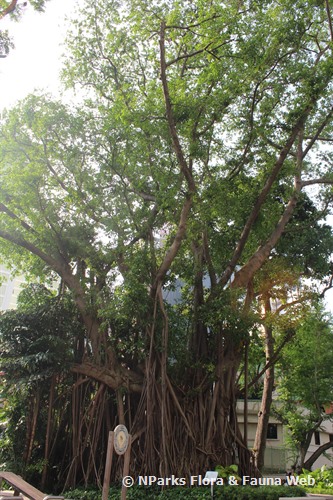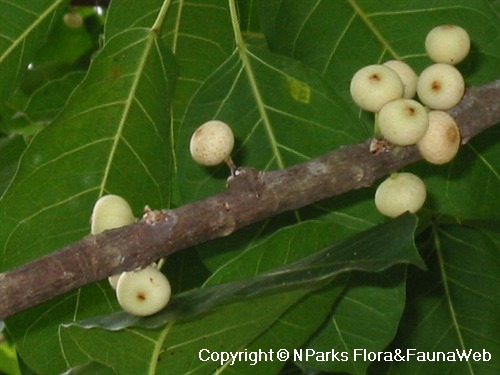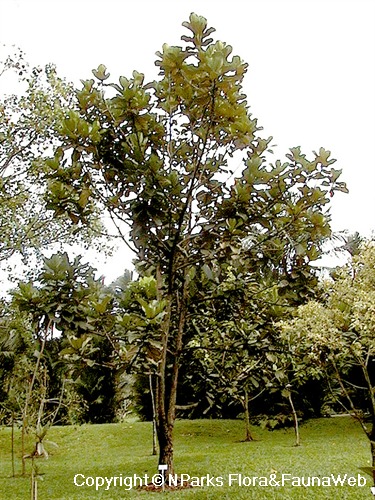
Name
Classifications and Characteristics
| Plant Division | Angiosperms (Flowering Seed Plants) |
|---|---|
| Plant Growth Form | Tree |
| Mode of Nutrition | Autotrophic |
| Maximum Height | 20 m |
Biogeography
| Native Distribution | Myanmar, Thailand, Sumatra, Malay Peninsula and Borneo, including Anambas and Natoena Islands. |
|---|---|
| Native Habitat | Terrestrial |
| Preferred Climate Zone | Tropical |
| Local Conservation Status | Native to Singapore (Critically Endangered (CR)) |
Description and Ethnobotany
| Growth Form | It is a tree, up to 20 m tall. Twigs are 1–3 mm thick covered in small brown stiff hairs, and have nodal waxy glands. Internodes are hollow and the outermost layer of the stem can be flaky. Twigs often have small abortive axillary buds, similar to those below the leaves. |
|---|---|
| Foliage | Leaves are oblong to obovate (6–15(–27) cm long and 2–6(–9.5) cm wide), often asymmetric with long leaf tip, cuneate to obtuse base and 6 – 12 pairs of lateral veins. Leaf margin is often entire, sometimes slightly toothed towards the leaf tip. Both upper surface and lower surface are mostly smooth except for the midrib or veins which are sparsely covered in brown stiff hairs. Only the lower surface have cystoliths present, and sometimes small waxy glands in the axils of the lateral veins. Petiole is 0.5–2.5 cm long covered in stiff brown hairs. Falling off early, stipules is 0.5–1.5 cm long. |
| Others - Plant Morphology | Figs are borne on branchlets that may or may not be branched (up to 60 cm long). The fig is green turning yellow-brown, sub-globose (2 – 3.5 cm diameter) covered with warty lenticels. The mouth of the fig is 3 – 8 mm diameter, with bracts arranged in a rosette and pointing outwards. Inside the fig, the female flowers are pinkish red with a long smooth style. |
| Habitat | It is found in terrestrial forest, often along streams, up to 900 m altitude. |
| Similar | Ficus rosulata differs from F. schwarzii by having no hairs on the inner surface of the fig and on the style of the female flower. |
Landscaping Features
| Landscape Uses | Parks & Gardens |
|---|
Fauna, Pollination and Dispersal
| Pollination Method(s) | Biotic (Fauna) |
|---|
Plant Care and Propagation
| Light Preference | Full Sun |
|---|---|
| Water Preference | Moderate Water |
| Plant Growth Rate | Moderate |
Foliar
| Mature Foliage Colour(s) | Green |
|---|---|
| Mature Foliage Texture(s) | Papery, Leathery |
References
| References | Berg, C.C. . 2010. Redefinition of Ficus schwarzii and two new species of Ficus (Moraceae).. Blumea. 55. 115 - 117 Ho, B.C., Lua, H.K., Leong, P.K.F., Lindsay, S., Seah, W.W., Bazilah Ibrahim, Loo, A.H.B., Koh, S.L., Ali Ibrahim & Athen, P.. 2018. New records and rediscoveries of vascular plants in Bukit Timah Nature Reserve, Singapore. . Gardens' Bulletin Singapore. 70 (1). 33 - 55 |
|---|
Image Repository
Others
| Master ID | 33746 |
|---|---|
| Species ID | 8160 |
| Flora Disclaimer | The information in this website has been compiled from reliable sources, such as reference works on medicinal plants. It is not a substitute for medical advice or treatment and NParks does not purport to provide any medical advice. Readers should always consult his/her physician before using or consuming a plant for medicinal purposes. |







